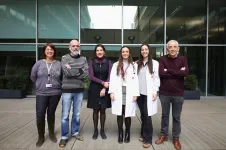(Press-News.org) Research Highlights:
In a study of U.S. military veterans, researchers noted that participating in home-based cardiac rehabilitation was associated with a 36% lower risk of death compared to veterans who chose not to participate in cardiac rehabilitation.
Less than half of the study participants enrolled in rehabilitation, which focused on improving heart-healthy behaviors.
The research may be the first U.S. study to provide evidence of living longer with home-based cardiac rehabilitation in people with heart disease.
Embargoed until 4 a.m. CT/5 a.m. ET Wednesday, March 1, 2023
DALLAS, March 1, 2023 — Participating in home-based cardiac rehabilitation after a heart attack or cardiac procedure was associated with a 36% lower likelihood of death from heart-related complications among U.S. military veterans within four years compared to those who opted out of rehabilitation programs, according to new research published today in the Journal of the American Heart Association, an open access, peer-reviewed journal of the American Heart Association.
Although cardiac rehabilitation has been shown to reduce the risks of hospital readmissions and death, it is significantly underused, according to the American Heart Association. Cardiac rehabilitation emphasizes eliminating tobacco use, improving diet, engaging in physical exercise, managing stress and taking medications that treat high blood pressure or high cholesterol.
“Whether in a hospital or home, cardiac rehabilitation is all about healthy behavior changes,” said senior study author Mary A. Whooley, M.D., a primary care physician at the San Francisco Veterans Affairs (VA) Medical Center and professor of medicine at the University of California, San Francisco. “However, changing behaviors is difficult, and while care facilities may offer on-site cardiac rehabilitation, many patients don’t choose to take advantage of follow-up treatment. The biggest surprise of our analysis was how few patients chose to participate in cardiac rehabilitation.”
While cost can be a barrier to participating in cardiac rehabilitation, along with geography and logistics, cost should not have been a factor as health care services were covered by the VA in this study.
“We don’t know why so many patients opted out of rehabilitation,” Whooley said. “Even when home-based cardiac rehabilitation was offered at the time and place of their choosing, only 44% of eligible patients chose to participate. Many patients were simply not interested in changing their behaviors.”
Data indicated that among patients hospitalized for heart attack from 2007-2011, only 16% of Medicare patients and 10% of veterans participated in cardiac rehabilitation. Among eligible Medicare beneficiaries in 2016, only 24% opted to participate in on-site/facility-based cardiac rehabilitation. According to the Million Hearts® Cardiac Rehabilitation Collaborative, a national initiative co-led by the Centers for Disease Control and Prevention and the Centers for Medicare & Medicaid Services, it’s estimated that increasing cardiac rehabilitation participation to 70% of cardiac patients after hospitalization could save 25,000 lives and prevent 180,000 additional hospitalizations each year.
“Many randomized trials have demonstrated similar mortality benefits from home-based and facility-based cardiac rehabilitation,” Whooley said.
This is the first U.S. study to provide evidence of survival benefit with home-based cardiac rehabilitation in people with heart disease, according to the study authors. The ongoing COVID-19 pandemic which temporarily closed countless facility-based rehabilitation programs indicates a growing need to explore opportunities in telehealth care for people with heart disease, they said.
This study analyzed data for 1,120 veterans who were eligible for cardiac rehabilitation at the San Francisco VA Medical Center between August 2013 and December 2018. Among this study group, 98% were men, 2% were women, 76% were white, 88% were non-Hispanic and 68% lived in an urban area. About half had been hospitalized for percutaneous coronary intervention — also known as angioplasty, 20% for coronary artery bypass grafting, 14% for heart attack and 18% for other reasons. Enrolling in the San Francisco Healthy Heart home-based cardiac rehabilitation program was voluntary, and only 44% (490 people) enrolled.
The home-based cardiac rehabilitation program lasted 12 weeks, during which participants received up to nine coaching calls, motivational interviews, a workbook and a personal health journal to document vital signs, exercise and diet. They also received a blood pressure monitor, a scale and (if desired) a stationary bike. A nurse or exercise physiologist worked one-on-one with participants to create achievable physical activity goals. Participants received follow-up phone calls from program staff at three and six months after program completion and were followed for an average of 4.2 years after hospitalization.
Among the researchers’ findings:
The death rate at one-year after hospitalization was 4% among those who did not participate in cardiac rehabilitation versus 2% among those who participated in home-based cardiac rehabilitation.
Overall, those who participated in the cardiac rehabilitation program were linked with a 36% reduction in odds of dying from complications compared with those who did not.
Deaths during the entire follow-up period occurred in 12% of rehabilitation participants versus 20% of non-participants.
Researchers note scientists don’t yet know the optimal number of at-home cardiac rehabilitation sessions are needed to achieve lasting success for people with heart disease, and this warrants further research. Moreover, when compared with traditional, facility-based programs, researchers believe home-based cardiac rehabilitation may lead to more lasting behavior changes that improve outcomes, because integrating healthy behaviors into a participant’s home routine from the outset has been associated with better adherence rates.
While there is no standardized approach to delivering home-based cardiac rehabilitation, it is generally shorter than on-site care, and “as technology expands, behavior modification in a participants’ own home environment may help make cardiac rehabilitation more accessible and lifestyle changes more sustainable,” Whooley said.
Another advantage of home-based cardiac rehabilitation is that, because capacity is not constrained by the availability of facility-based programs, it has shorter wait times to begin therapy (average of 25 days versus 77 days after a cardiac event).
“Our biggest challenge in the U.S. is that home-based cardiac rehabilitation is not covered by many health insurers,” she said. “Currently, Medicare only pays for on-site or facility-based cardiac rehabilitation.”
The American Heart Association supports congressional legislation such as the bipartisan “Increasing Access to Quality Cardiac Rehabilitation Care Act,”’ which calls for expanding cardiac rehabilitation resources.
Randal J. Thomas, M.D., chair of the 2019 joint American Heart Association/American College of Cardiology statement on the effectiveness of home-based cardiac rehabilitation called this study a “unique, landmark report.”
“This study suggests that home-based cardiac rehabilitation is associated with a lower death rate when compared to individuals who receive no cardiac rehabilitation,” said Thomas, who is professor of medicine in the Mayo Clinic Alix School of Medicine working with the Mayo Clinic Cardiac Rehabilitation Program in Rochester, Minnesota. “Previous home-based cardiac rehabilitation studies have not been designed to address this important benefit. Additional studies are needed, but this study strongly suggests a mortality benefit from home-based cardiac rehabilitation.
“Even though the study did not clarify if home-based cardiac rehabilitation impacts death rates as well or even better than center-based rehabilitation, it does show that home-based cardiac rehabilitation reduces death rates compared to those patients who do not participate in cardiac rehabilitation.”
The joint statement strongly recommends cardiac rehabilitation for people diagnosed with heart attack, chest pain, heart failure or after having bypass surgery, percutaneous coronary intervention, heart valve surgery or heart transplantation. In addition, an American Heart Association scientific statement notes that home-based rehabilitation is an effective alternative to cardiac rehabilitation for those unable to participate in an on-site cardiac rehabilitation program.
The study has several limitations, including that there was no comparison to facility-based cardiac rehabilitation; participants were not randomized; and most were English-speaking, older men. Researchers note it’s unclear whether the benefits of home-based cardiac rehabilitation would produce similar benefits in women or non-English speaking people.
Co-authors are Nirupama Krishnamurthi, M.B.B.S, M.P.H.; David W Schopfer, M.D. M.A.S.; Hui Shen, M.Sc.; Gregory Rohrbach, D.N.P.; and Abdelaziz Elnaggar, M.B.B.S., M.P.H. Authors’ disclosures are listed in the manuscript.
The Veterans Health Services Research and Development Quality Enhancement Research Initiative funded the study.
Studies published in the American Heart Association’s scientific journals are peer-reviewed. The statements and conclusions in each manuscript are solely those of the study authors and do not necessarily reflect the Association’s policy or position. The Association makes no representation or guarantee as to their accuracy or reliability. The Association receives funding primarily from individuals; foundations and corporations (including pharmaceutical, device manufacturers and other companies) also make donations and fund specific Association programs and events. The Association has strict policies to prevent these relationships from influencing the science content. Revenues from pharmaceutical and biotech companies, device manufacturers and health insurance providers and the Association’s overall financial information are available here.
Additional Resources:
Multimedia is available on the right column of release link https://newsroom.heart.org/news/home-based-cardiac-rehabilitation-may-help-people-live-longer?preview=6fa229c1f5389a40f9ab47db85319295
After March 1, view the manuscript online.
AHA health information: Cardiac Rehab: Frequently Asked Questions
AHA news release: Less than 10% of adults with heart failure get cardiac rehab despite Medicare expansion (Nov. 2021)
AHA news release: Bipartisan legislation to increase access to cardiac and pulmonary rehabilitation programs introduced in the House of Representatives (March 2021)
AHA news release: Remote cardiac rehabilitation programs are effective alternatives to on-site services (Nov. 2020)
Follow AHA/ASA news on Twitter @HeartNews
Follow news from the Journal of the American Heart Association @JAHA_AHA
About the American Heart Association
The American Heart Association is a relentless force for a world of longer, healthier lives. We are dedicated to ensuring equitable health in all communities. Through collaboration with numerous organizations, and powered by millions of volunteers, we fund innovative research, advocate for the public’s health and share lifesaving resources. The Dallas-based organization has been a leading source of health information for nearly a century. Connect with us on heart.org, Facebook, Twitter or by calling 1-800-AHA-USA1.
###
END
Home-based cardiac rehabilitation may help people live longer
Participating in home cardiac rehabilitation was linked with a lower risk of death among veterans during a four-year-follow up, finds new study in the Journal of the American Heart Association
2023-03-01
ELSE PRESS RELEASES FROM THIS DATE:
Flamingos form cliques with like-minded pals
2023-03-01
Flamingos form cliques of like-minded individuals within their flocks, new research shows.
Scientists analysed the personalities and social behaviour of Caribbean and Chilean flamingos.
Birds of both species tended to spend time with others whose personality was similar to their own.
The study, by the University of Exeter and the Wildfowl & Wetlands Trust (WWT), reveals the complex nature of flamingo societies and could help in the management of captive flocks.
“Our previous research has shown that individual flamingos have particular ‘friends’ within the flock,” said Dr Paul Rose, from WWT and Exeter’s Centre for Research in Animal Behaviour.
“In ...
Social workers experienced depression, PTSD, and anxiety at alarming rates during pandemic
2023-03-01
Toronto, ON — A new study published in the journal International Social Work has uncovered concerning rates of depression, post-traumatic stress disorder (PTSD) and anxiety among social workers.
Stressors related to COVID-19 were the strongest factors associated with the negative mental health outcomes. Those who experienced a higher number of pandemic-related stressors — such as health concerns, increased caregiving responsibilities, violence in the home, family stress due to confinement, and stress associated with work-life balance — experienced mental health problems ...
Woodcocks have the brightest white feathers ever measured
2023-03-01
The mainly brown woodcock uses its bright white tail feathers to communicate in semi-darkness, reflecting 30% more light than any other known bird.
These surprise findings, by a team led by an Imperial College London scientist, suggest there is much to learn about how birds that are most active at night or at dawn and dusk communicate.
Birds that are most active during the day often have colourful plumages, which they use to communicate information with each other. Birds that are most active at dawn and dusk or at night (‘crepuscular’), such as nightjars and woodcocks, tend to have less showy plumage, as while sleeping during ...
Marker discovered which shows when a type of skin cancer is preparing to metastasise
2023-03-01
Cells that form cutaneous squamous cell carcinoma tumours prepare themselves to migrate to the lymph nodes to metastasise other organs, and they make changes so that they can survive this process. According to a study led by researchers from the Inflammatory and Neoplastic Dermatological Diseases Research Group at the Hospital del Mar Medical Research Institute, published in the journal Life Science Alliance, these cells stop consuming glucose so that they can survive by using LDL cholesterol molecules, the ...
Conversations about safe firearm storage at purchase can influence use of firearm locks
2023-03-01
Although cable locks – commonly distributed to prevent firearm injury and death – are included in many legal firearm purchases, research shows firearm owners rarely prefer or use these devices.
But a Rutgers study published in Injury Epidemiology found that gun owners who were told about cable locks at the time they purchased the firearm were more than twice as likely to use locking devices than those who weren’t told about cable locks when they made these purchases.
“Simply placing a cable lock in a bag when somebody purchases a firearm likely has minimal impact, but a simple discussion mentioning that a lock was included may make enough of an ...
Daily 11 minute brisk walk enough to reduce risk of early death, say Cambridge researchers
2023-03-01
One in ten early deaths could be prevented if everyone managed at least half the recommended level of physical activity, say a team led by researchers at the University of Cambridge.
In a study published today in the British Journal of Sports Medicine, the researchers say that 11 minutes a day (75 minutes a week) of moderate-intensity physical activity – such as a brisk walk – would be sufficient to lower the risk of diseases such as heart disease, stroke and a number of cancers.
Cardiovascular diseases – such as heart disease and stroke – are the leading cause of death globally, ...
Pink + pink = gold: hybrid hummingbird’s feathers don’t match its parents
2023-03-01
The Pink-throated Brilliant hummingbird, Heliodoxa gularis, has, unsurprisingly, a brilliant pink throat. So does its cousin, the Rufous-webbed Brilliant hummingbird, Heliodoxa branickii. When scientists found a Heliodoxa hummingbird with a glittering gold throat, they thought they might have found a new species. DNA revealed a different story: the gold-throated bird was a never-before-documented hybrid of the two pink-throated species.
John Bates, the senior author of a new study in the journal Royal Society Open Science reporting on the hybrid, first encountered the unusual bird while doing fieldwork in Peru’s Cordillera ...
Researchers identify three intestinal bacteria found in dementia with Lewy bodies
2023-03-01
Dementia with Lewy bodies (DLB), one of the most common forms of dementia, has no cure. Previous studies suggested that gut bacteria, the microorganisms that live in the human digestive tract, play a role in Parkinson’s disease, another neurodegenerative disorder, but the bacteria involved in DLB had not been identified. Now, a group led by researchers at the Nagoya University Graduate School of Medicine in Japan has identified three bacteria involved in DLB: Collinsella, Ruminococcus, and Bifidobacterium. Their findings, reported in npj Parkinson's ...
Scientists find that bison are impacting streams in Yellowstone National Park
2023-03-01
Greater numbers of Bison in Yellowstone National Park may come at a cost to the biological diversity of the important streamside habitats of the Park according to a new report in the journal Ecosphere Bison influences on composition and diversity of riparian plant communities in Yellowstone National Park. Riparian areas (streamside zones) form the interface between terrestrial and aquatic ecosystems and are hotspots of biodiversity and productivity in the public lands of the Western USA. The study findings are that ...
Keto vs vegan: Study of popular diets finds over fourfold difference in carbon footprints
2023-03-01
For those on keto or paleo diets, this may be tough to swallow.
A new study from Tulane University which compared popular diets on both nutritional quality and environmental impact found that the keto and paleo diets, as eaten by American adults, scored among the lowest on overall nutrition quality and were among the highest on carbon emissions.
The keto diet, which prioritizes high amounts of fat and low amounts of carbs, was estimated to generate almost 3 kg of carbon dioxide for every ...
LAST 30 PRESS RELEASES:
Making lighter work of calculating fluid and heat flow
Normalizing blood sugar can halve heart attack risk
Lowering blood sugar cuts heart attack risk in people with prediabetes
Study links genetic variants to risk of blinding eye disease in premature infants
Non-opioid ‘pain sponge’ therapy halts cartilage degeneration and relieves chronic pain
AI can pick up cultural values by mimicking how kids learn
China’s ecological redlines offer fast track to 30 x 30 global conservation goal
Invisible indoor threats: emerging household contaminants and their growing risks to human health
Adding antibody treatment to chemo boosts outcomes for children with rare cancer
Germline pathogenic variants among women without a history of breast cancer
Tanning beds triple melanoma risk, potentially causing broad DNA damage
Unique bond identified as key to viral infection speed
Indoor tanning makes youthful skin much older on a genetic level
Mouse model sheds new light on the causes and potential solutions to human GI problems linked to muscular dystrophy
The Journal of Nuclear Medicine ahead-of-print tip sheet: December 12, 2025
Smarter tools for peering into the microscopic world
Applications open for funding to conduct research in the Kinsey Institute archives
Global measure underestimates the severity of food insecurity
Child survivors of critical illness are missing out on timely follow up care
Risk-based vs annual breast cancer screening / the WISDOM randomized clinical trial
University of Toronto launches Electric Vehicle Innovation Ontario to accelerate advanced EV technologies and build Canada’s innovation advantage
Early relapse predicts poor outcomes in aggressive blood cancer
American College of Lifestyle Medicine applauds two CMS models aligned with lifestyle medicine practice and reimbursement
Clinical trial finds cannabis use not a barrier to quitting nicotine vaping
Supplemental nutrition assistance program policies and food insecurity
Switching immune cells to “night mode” could limit damage after a heart attack, study suggests
URI-based Global RIghts Project report spotlights continued troubling trends in worldwide inhumane treatment
Neutrophils are less aggressive at night, explaining why nighttime heart attacks cause less damage than daytime events
Menopausal hormone therapy may not pose breast cancer risk for women with BRCA mutations
Mobile health tool may improve quality of life for adolescent and young adult breast cancer survivors
[Press-News.org] Home-based cardiac rehabilitation may help people live longerParticipating in home cardiac rehabilitation was linked with a lower risk of death among veterans during a four-year-follow up, finds new study in the Journal of the American Heart Association





